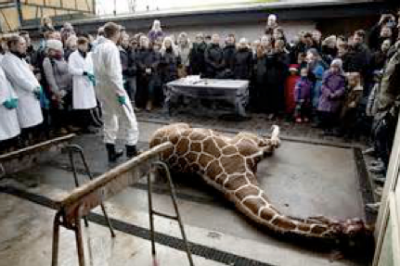|

EAZA is the European Association of Zoos and Aquaria – the governing body of a large number of zoos in Europe. A zoo in Europe does not need to be a member of EAZA – for example, in the UK it is the local authorities that are responsible for licensing. Such local authorities vary widely in their competence to licence a zoo, and are assisted by UK Government appointed zoo inspectors in licensing procedures, renewals, and periodic inspections. However, membership of the British and Irish Association of Zoos and Aquaria and/or EAZA pays dividends to the zoo in terms of recognition by the public that the animals in the “collection” meet national and international standards of ethics and welfare.
Or so we are led to believe?
Let’s have a look at the EAZA recommendations concerning “culling” or “euthanasia” or “removal” or let’s call it by the right name – killing of animals in zoos – published on 30 April 2015 and approved by the EAZA Council:
1. Killing must be “humane” and carried out by appropriately qualified and experienced staff;
2. EAZA members must take “seriously” their obligations to population management;
3. EAZA members must “strive” to ensure that their animals are kept in circumstances that enable the “expression of as wide a range of normal behaviours as possible”. This includes “normal and regular breeding behaviours on a natural cycle where rearing of juveniles forms part of that behaviour”. [Read that carefully, I’ll come back to that below…]
4. EAZA members can, under certain circumstances, sacrifice the “right to life of specific individual animals” to fulfil “defined conservation goals and the viability of the overall population”.
5. EAZA recognizes the “challenge of explaining best practice and the role of culling in conservation to the public” [In other words, it could be very controversial…]
6. EAZA considers culling a standard operating procedure when an animal poses a serious risk to human safety – or when the animal is suffering from, disease, psychological stress, or pain. Or when the presence of an animal is disruptive to others in the group, or when that animal is a risk to genetic viability.
7. EAZA is of the opinion that “limiting the opportunity to breed … reduces an animal’s opportunity to express one of the most important and complex set of natural behaviours and can thus lead to a decrease in welfare. EAZA considers culling of offspring an appropriate tool for maintaining the welfare of parent animals…” [Read that twice or three times – I’ll come back to that…]
8. “Culling of animals which can reasonably be expected to cause a strong public or media reaction should be communicated by the member responsible and/or the EEP coordinator to the EAZA Communications and Membership Manager” [Damage control].
In short, EAZA endorses killing of animals in zoos as a management and conservation tool. Specifically, EAZA endorses killing of animals which:
1. Suffer from psychological stress [how unusual is that in a caged animal?];
2. Don’t fit in with the “group” [this is artificial selection to encourage docile and zoo-adapted animals];
3. Result from breeding conducted to satisfy the “welfare” of adult animals which need to be allowed to express “natural behaviours” [in other words, breeding is not a problem because the adults would otherwise not be able to “experience parenthood” however short – also, zoos make much money by attracting the public to see baby animals that they then later kill as an “appropriate” means of reducing excess animals];
4. Can be kept away from public and media scrutiny.
I’ll leave it to you to reach your own conclusions on the above. But meanwhile, don’t expect zoos to change their standard operating procedures of killing animals unless and until their governing bodies take a much stronger stance than this dithering set of guidelines presented by EAZA?
Picture credit: penn live.com
|




